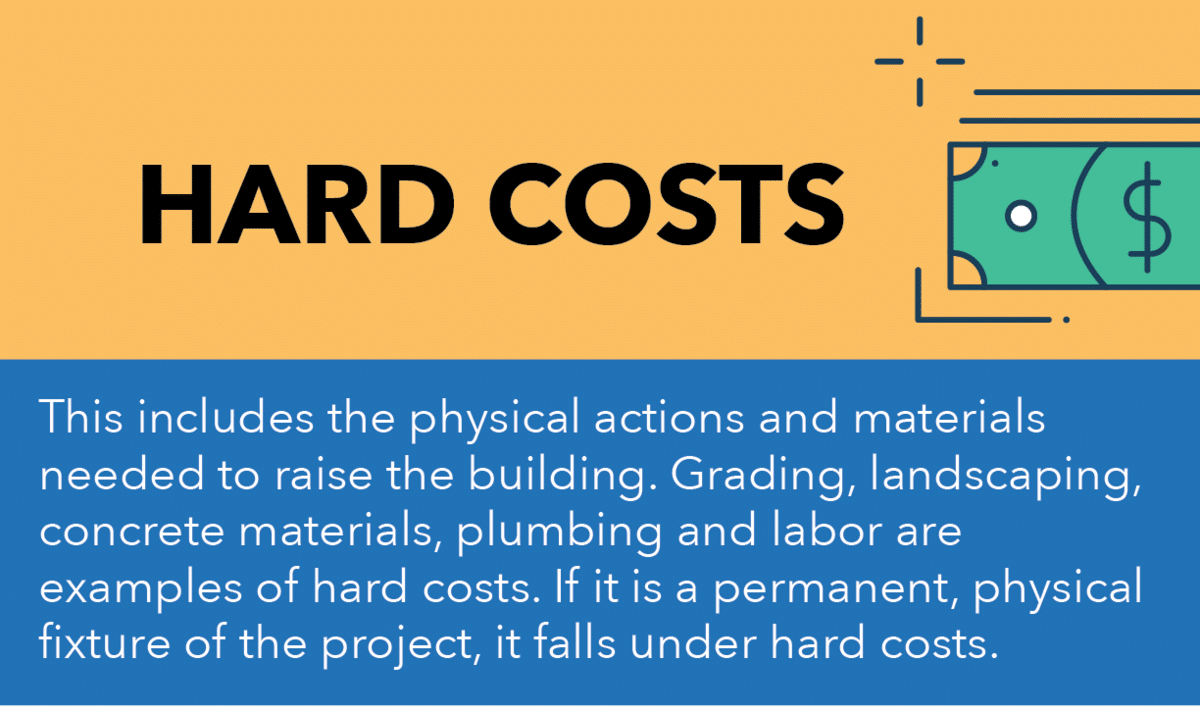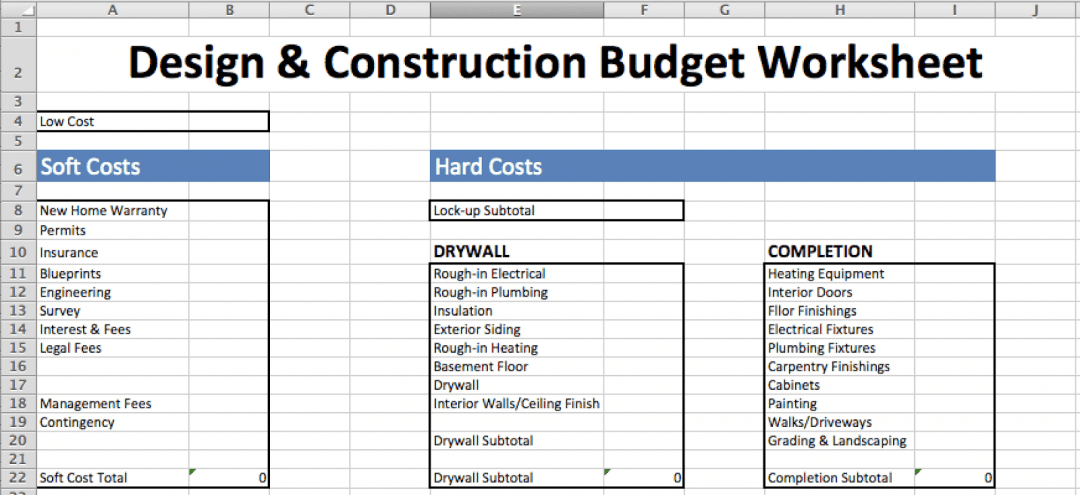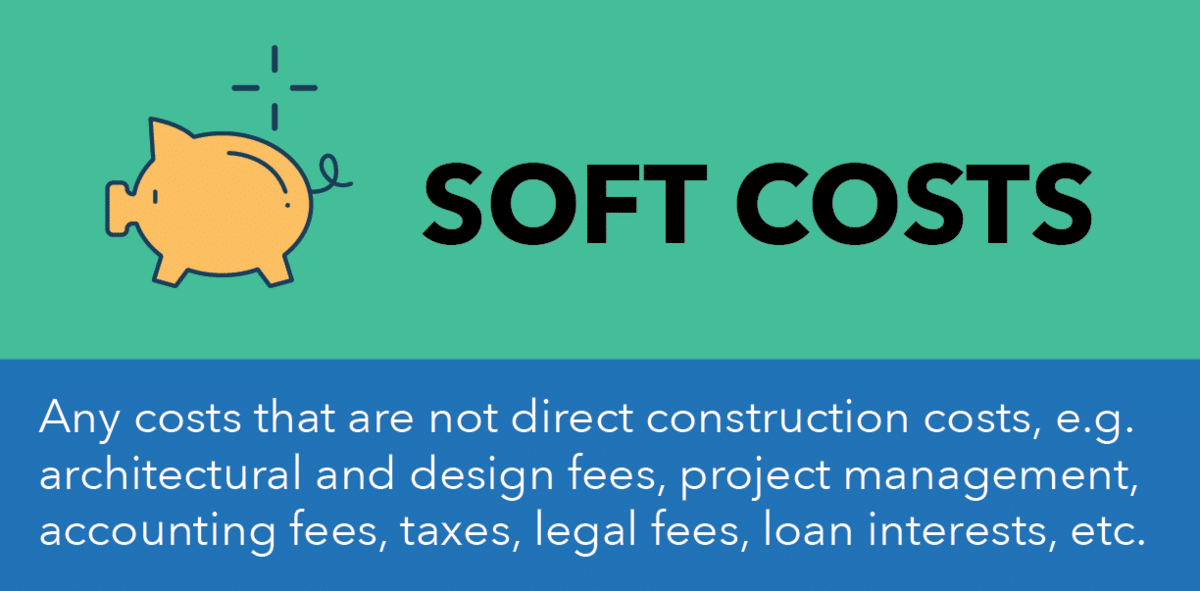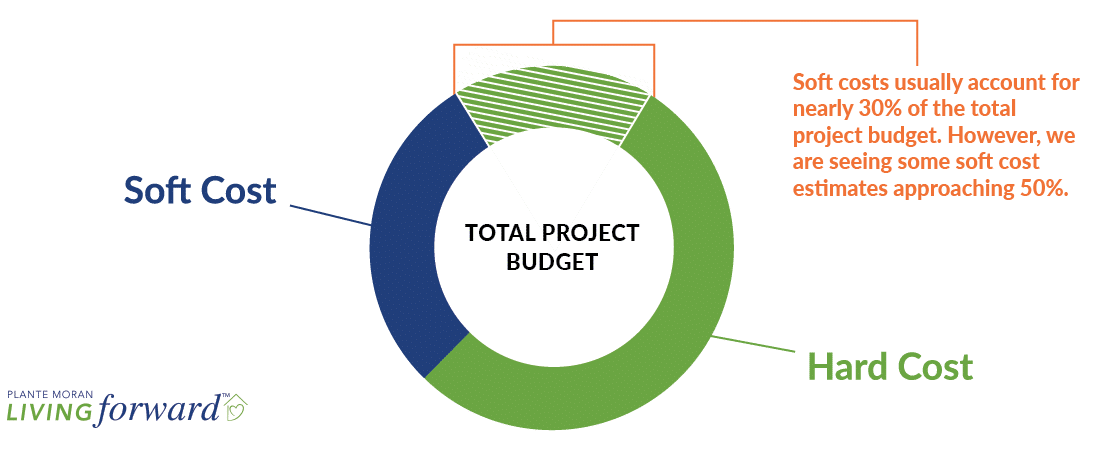Understanding the difference between hard costs and soft costs in construction is vital when building a project budget.
Responsible project managers and proposal teams attempt to project a budget that lands as close as possible to the final cost.
Knowing what hard costs and soft costs are ensures that the construction company can include all upfront and “hidden” costs when drawing up a master plan.
Without a firm grasp on this distinction, it becomes dangerously easy to misclassify costs, or worse, accidentally omit items from the budget.
Understanding the difference also helps to ensure that clients fully grasp what the project will cost, as well as why.
In this article...
What Are the Hard Costs in Construction?
Hard costs in construction are what most people usually think of when they consider the supplies and items necessary for a construction project.
They are tangible and physical. Here is a workable definition of hard costs:

Professional estimators can help to accurately establish the hard costs of a project.
This includes sifting through recent data involving materials, travel costs, and financial risk assessments.
When hard costs are accurate, both the project manager and the client feel confident about how much the structure will cost at various milestones, as well as in total.
To make the many individual items in a hard costs budget manageable, it’s a good idea to sort them into smaller categories.
The first and most visible section when considering hard costs is the building structure. This involves the materials needed to complete the project, such as the following:
- Drywall
- Steel beams
- Lumber
- Windows
- Concrete
- Nails
- Landscaping materials
Even though it is not a tangible item, the labor required to construct the building is also involved in the hard cost estimate.
Most companies usually take overtime and other associated costs into account.
Additionally, depending on the type of project and the area in which the construction is taking place, LEED certification fees might also factor into hard costs.
The next category includes site-related costs.
An easy way to organize site-related costs is to include all items associated with implanting and delivering utilities such as water, gas, and electricity.
Site-related costs include drains, underground utilities, site grading, driveway paving, and more. Training fees are sometimes also considered hard costs.
Soil tests, engineering reports, foundation upgrades, pollution control, and attention to sediment issues also fall under that category.
The landscaping division is perhaps the easiest to categorize. This involves costs for grass installation or seeding, shrub placement, mulch, trees, cacti, flowers, or other plants.
Usually, the architect for the project works with landscaping specialists to recommend the most appropriate landscaping items for the project.
Finally, contingency funds, change orders, and overheads are all included under the hard cost umbrella.
A contingency fund is set aside to meet the costs that might arise from unforeseen events or conditions, such as finding unanticipated soil conditions after breaking ground.
Typically, contingency funds are as little as five or as much as ten percent of the cost of a new build.
For remodeling, most teams reserve ten to twenty percent of the total cost for emergencies.
How to Estimate Hard Costs
Hard costs might change through a project due to market forces or weather emergencies such as a hurricane, but they are usually quantifiable or closely projected from data collected on similar projects.
Modeling costs or using projection equations usually default to a high contingency allotment.
However, the final hard cost of a project is usually not developed until contracts are underway with third parties, real estate transactions are closing, and plans are finalized.
Using a template such as the one seen below to estimate hard costs is useful:

As you can see, this example not only includes such items as electrical parts, flooring, and plumbing, but it also divides them into project phases.
This makes the budgeting load even more understandable and manageable. When clients can see each item according to a timeline, it can be easier to consider budgeting priorities.
Of course, a change in one section will affect another.
For example, if a client decides to add a breakfast nook during the planning phase, that will raise the cost of completion, because carpentry, painting, and hardware are necessary to add the item.
The hard cost estimation process is sometimes considered easier to calculate because it involves fixed prices based on data-driven estimates.
However, it’s all too easy to fall into the following mistakes when developing the final amount:
- Underestimating project duration
- Failure to allow for increasing costs
- Omitting items
- Misunderstanding project schedule
These missteps are avoidable if the estimator takes into account the feasibility of the job, as well as the specifics of a larger project, such as a design-build that involves more than one structure.
Estimators can help project managers account for items they might not consider as part of the budget, such as obscure real estate-related fees.
Early in the project, construction teams might deliver what’s known as a ballpark estimate.
These are usually the least accurate estimates, especially if the project is especially complicated or involves unusual structures.
Hard cost estimates become more accurate as the actual construction phase draws near.
High-level estimates, the next step in the process, are usually accurate within thirty percent.
They are closer to the final cost because the contractor now has more information about the project and a better handle on what the client wants to see.
Finally, the delivery of a detailed estimate includes line items, consideration of third-party contracts, and supply costs based on current market prices.
What Are the Soft Costs in Construction?
Contractors and project managers must also consider the soft costs of a construction project.
Although some items may vary between hard cost or soft cost inclusion, soft costs usually include the following:

Soft costs vary widely, and some might come as a surprise to those not familiar with the details of construction projects.
They usually account for about thirty percent of a construction budget. Soft costs also involve furnishing items like chairs, appliances, computers, or other tech items.
Other examples of costs that estimators typically consider soft also include:
- Project management
- Assessment
- Radio communication systems
- Office equipment
- Security
- Public relations
- Consulting fees
- Development advisor costs
- Traffic studies
Construction companies usually rely on automation and GPS tracking to verify material delivery, distribute labor forces, track tools, and manage equipment fleets.
However, business owners and administrators can guard the investment in their soft cost items by using systems such as GoCodes asset tracking software.
Asset tracking software is an essential part of any modern business.
It involves affixing labels or QR codes to any item, then scanning it with a mobile device or barcode scanner to gain information about the item or to create input about its status.
Asset tracking can also involve RFID tags or BlueTooth technology.
As part of soft cost management, team members can note the location of an item, see to its maintenance, ensure its security, and much more.
How to Estimate Soft Costs
Soft costs can be frustrating to calculate because they are sometimes presaged on hourly charges that can vary widely, and they do not involve tangible building materials such as roof shingles or siding.
In addition, these costs might fluctuate depending on third-party agreements.
However, experienced estimators, contractors, and project managers can usually produce a soft cost budget section with a “best range” approach, or by setting aside thirty percent of the final budget and providing more detailed breakdowns as the project draws closer.

Soft costs might also involve expenses that come in after the actual construction of a building is complete.
Project managers might find themselves suddenly tasked with gaining environmental permissions, litigation, increased security, or other factors.
Contractors can also provide a more accurate soft cost estimate by undertaking a strong risk assessment matrix.
Projecting the likelihood of various events, as well as developing contingency plans to address them, can help to develop a more accurate soft costs budget.
Another way to develop a soft costs budget for a construction project is to dedicate time to understanding government regulations and taxes.
This helps to avoid unwelcome surprises after the building is complete; it saves time and money to research building code requirements and ensures that the project meets them.
That’s far cheaper and simpler than instituting changes after completion.
Conclusion
Understanding the differences between hard costs and soft costs in construction will help both the project manager and the client work harmoniously and with transparency.
Hard costs consist of the tangible items needed to complete a construction project, as well as the labor to do the job.
Since these costs cease after construction completion, and items are quantifiable, they are usually more accurate and easier to calculate than soft costs.
Soft costs involve building furnishings, professional service fees such as architecture costs, and “cost of doing business” budget items like communication systems, office space, advertising, and public relations.
Sometimes, soft costs such as legal fees can arise after labor forces complete work on the project. Both hard cost and soft cost items are more manageable with asset tracking software.




